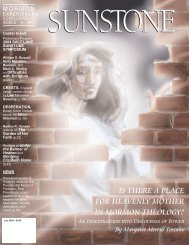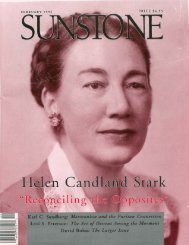Download Entire Issue PDF - Sunstone Magazine
Download Entire Issue PDF - Sunstone Magazine
Download Entire Issue PDF - Sunstone Magazine
Create successful ePaper yourself
Turn your PDF publications into a flip-book with our unique Google optimized e-Paper software.
S U N S T O N E<br />
settlement on their ancestral lands, and he successfully used<br />
this violent campaign to get elected as U.S. president in<br />
1840. 13 In 1842, Abraham Lincoln nearly engaged in a<br />
sword duel with the Illinois state auditor. 14<br />
Violence in the classroom was also common in early<br />
America. In 1802, students at Princeton University burned<br />
down the library; before 1830 had arrived, they had engaged<br />
in five other “major campus rebellions.” Student rioting and<br />
violence also plagued the University of Virginia during the<br />
1830s and 1840s. The problem was even worse at public<br />
schools where the children of farmers, shopkeepers, and<br />
common laborers were educated. In 1837 alone, 400 schools<br />
had to be closed in Massachusetts because of violence and<br />
disciplinary problems. 15 From colonial times to the mid-<br />
1840s, it was a tradition in Philadelphia on Sundays for<br />
young men to commit both “organized and spontaneous<br />
mayhem.” 16<br />
The pervasiveness of violence in early American culture,<br />
particularly by men, leads to an obvious question. Did every<br />
early American man, or even the vast majority, commit assault<br />
and battery? Existing evidence indicates that the answer<br />
is “no” for a large portion of American males during<br />
that era.<br />
Why did many early American males avoid violence, even<br />
though it was socially sanctioned? Opinion polls did not<br />
exist, relatively few American males wrote diaries or letters<br />
about their personal feelings, and even fewer commented<br />
about their responses to violence (aside from service in the<br />
military). Therefore, the answer can be only tentative, but<br />
many early American males apparently declined to participate<br />
in their country’s culture of violence because of some<br />
combination of the following factors: non-aggressiveness in<br />
their personalities, their adherence to the Christian commandment<br />
to “turn the other cheek” (Matthew 5:39), family<br />
indoctrination against violence, or their perception that<br />
there was never sufficient cause for them to resort to violence<br />
in their daily lives.<br />
Because many American males (and nearly all females)<br />
avoided violence, we might question whether there really<br />
was a “culture of violence” in early America. To answer that<br />
question, we need more than arrest records, or anecdotal references<br />
to violent incidents, or even estimates of those who<br />
did not engage in violent acts. Rather, we need to ask a more<br />
fundamental question: What were the norms of the society<br />
regarding violence?<br />
In terms of the previously cited examples of legally and<br />
socially sanctioned violence in daily life and of the election<br />
of national leaders with violent reputations, it should be obvious<br />
why historians regard early America as a violent culture.<br />
Though the incidents of violence are certainly important,<br />
both individually and statistically, the crucial question<br />
is whether the violent incidents occurred in concert with the<br />
society’s norms or in opposition to them.<br />
C. C. A. Ch r is t en s en : Det Ail f r o m “h Au n ’s mil l ”<br />
IT MAY BE difficult for the majority of those who follow<br />
the Restoration message that began with the 1830 Book<br />
of Mormon to conceive of early Mormon culture as<br />
being violent. 17 After all, the Book of Mormon’s narratives<br />
endorsed self-defensive wars (Alma 43: 26, 47) but also expressed<br />
discomfort or condemnation of violence in daily life<br />
(1 Nephi 4:7–18; Mosiah 29:14; Alma 35:15; 48:11).<br />
Members of the Community of Christ, headquartered in<br />
Independence, Missouri, can point to a tradition of gentle<br />
co-existence with their neighbors which extends to that<br />
movement’s founding in the 1850s. 18 Members of the LDS<br />
Church, headquartered in Salt Lake City, can point to a similar<br />
tradition throughout their own lifetime and that of their<br />
parents, grandparents, sometimes great-grandparents and<br />
great-great-grandparents. 19<br />
However, the Utah church’s peaceful norms extend back<br />
only to the 1890s, 20 and the Community of Christ’s norms<br />
do not define the Mormonism which existed before the<br />
Reorganization of the 1850s. To avoid the “presentist bias”<br />
OCTOBER 2011 PAGE 17

















